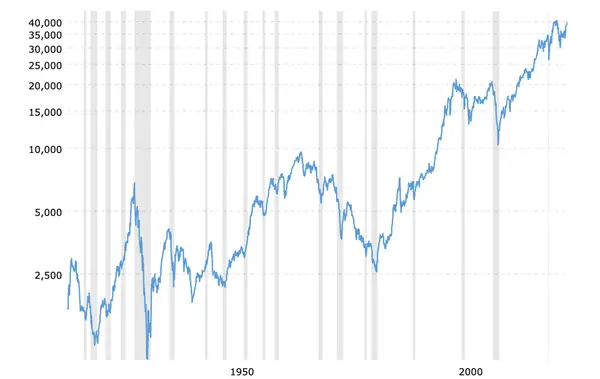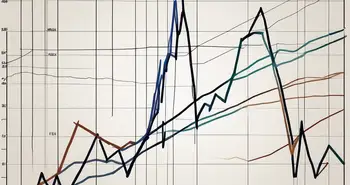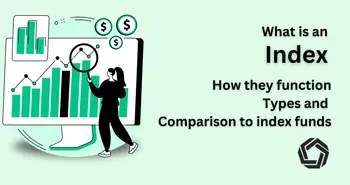Dow Jones Explained for Dummies

As an expert in finance, I understand the complexities that can overwhelm newcomers to the world of Wall Street and the stock market. Within this realm, the Dow Jones Industrial Average, often simply referred to as the Dow Jones, stands as a beacon of global financial analysis. Over the span of 34 years from February 1990 to February 2024, the Dow Jones Industrial Average index demonstrated impressive performance metrics. Boasting a compound annual growth rate of 11.26% (in EUR), it showcased a consistent upward trajectory, reflecting its significance as a key barometer of market health. In this article, I will embark on a comprehensive journey through the fundamentals of the Dow Jones, uncovering its rich history, elucidating its pivotal role in the financial landscape, and offering invaluable insights into effective investment strategies for this esteemed index.
What is the Dow Jones?
The Dow Jones Industrial Average is a price-weighted index that tracks the performance of 30 large, publicly-traded companies in the United States. These companies, known as blue-chip stocks, are industry leaders in sectors such as technology, finance, and healthcare. Unlike the S&P 500, which is market-cap-weighted, the Dow assigns weights based on the stock prices of its components, meaning higher-priced stocks have a greater impact on the index's movements.
The History of Dow Jones
The Dow Jones Industrial Average, established in 1896 by Charles Dow and Edward Jones, has forged a storied path over the past century, embodying the ebbs and flows of American economic history. Initially comprising a modest roster of 12 companies, the index has burgeoned to encompass 30 of the most influential corporations across various sectors, encapsulating the essence of the stock market.

In the aftermath of World War I, the Dow Jones Index bore witness to the exuberance of the Roaring Twenties, a period of unprecedented economic prosperity marked by soaring stock prices and robust industrial expansion. However, the euphoria was short-lived, as the stock market crash of 1929 plunged the nation into the depths of the Great Depression, precipitating a decade-long era of economic turmoil and widespread hardship.
The subsequent decades saw the Dow Jones Index navigate through the trials and tribulations of war and recession, from the industrial mobilization of World War II to the economic resurgence of the post-war era. The advent of the Information Age in the latter half of the 20th century ushered in a new era of innovation and technological advancement, propelling the index to unprecedented heights and cementing its status as a beacon of economic progress.
The dawn of the 21st century brought with it a new set of challenges, as the dot-com bubble burst and the global financial crisis of 2008 rocked financial markets worldwide. Yet, through each upheaval, the Dow Jones Industrial Average remained steadfast, reflecting the resilience of the American economy and serving as a barometer of investor sentiment.
In 2023-2024, the Dow saw increased volatility due to inflationary pressures, the Federal Reserve's interest rate hikes, and uncertainties surrounding the technology and energy sectors. While the index still showed long-term stability, these events highlight the importance of understanding how broader economic factors can influence the Dow.
Today, as we stand at the threshold of a new era characterized by technological disruption and geopolitical uncertainty, the Dow Jones Index continues to evolve, adapting to the changing landscape of the global economy. Its rich tapestry of history serves as a testament to its enduring relevance and enduring legacy, embodying the spirit of innovation and resilience that defines the American entrepreneurial spirit.
Current Components of the Dow Jones Industrial Average (2024)
The Dow Jones Industrial Average (DJIA) consists of 30 prominent companies across various industries, each representing the economic strength of its respective sector. As of 2024, these companies play a significant role in shaping the movement of the index, providing investors with a snapshot of the overall health and trends of the U.S. stock market. Below is a list of the current components of the Dow Jones, offering a diversified representation of industries such as technology, healthcare, finance, and consumer goods.
- 3M (MMM)
- Amgen (AMGN)
- American Express (AXP)
- Apple (AAPL)
- Boeing (BA)
- Caterpillar (CAT)
- Chevron (CVX)
- Cisco Systems (CSCO)
- Coca-Cola (KO)
- Disney (DIS)
- Dow Inc. (DOW)
- Goldman Sachs (GS)
- Home Depot (HD)
- Honeywell (HON)
- IBM (IBM)
- Intel (INTC)
- Johnson & Johnson (JNJ)
- JPMorgan Chase (JPM)
- McDonald's (MCD)
- Merck & Co. (MRK)
- Microsoft (MSFT)
- Nike (NKE)
- Procter & Gamble (PG)
- Salesforce (CRM)
- Travelers Companies (TRV)
- UnitedHealth Group (UNH)
- Verizon Communications (VZ)
- Visa (V)
- Walgreens Boots Alliance (WBA)
- Walmart (WMT)
Are you ready to step into the world of trading and explore opportunities in the Dow Jones and other top stocks like Apple, Microsoft, Coca-Cola, and JPMorgan Chase? Morpher provides a seamless solution where you can invest with as little as $1, allowing you to control your investment without worrying about the price of individual stocks or commodities. Don't miss out on the future of trading – sign up now with Morpher and enjoy your welcome bonus!

How is the Dow Jones Index Calculated?
The calculation of the Dow Jones Index involves a somewhat intricate process that incorporates the share prices of its 30 component companies. Unlike other indexes like the S&P 500, where weighting is determined by market capitalization, the Dow Jones utilizes a different approach. Here, weights are assigned based on the share price of each individual company. This means that companies with higher share prices exert a greater influence on the index, regardless of their market capitalization. As a result, the movements of higher-priced stocks can have a more significant impact on the overall performance of the Dow Jones Index.
Unlike other indexes that use market capitalization, the Dow Jones is calculated by summing the stock prices of its 30 component companies and dividing that sum by the Dow Divisor.
Example:
If the total stock price of all companies in the Dow is $10,000, and the divisor is 0.147, the Dow Jones Index would be calculated as:
10,000 ÷ 0.147 = 68,027.21Understanding the Daily Fluctuations
It's important to remember that the Dow Jones experiences daily fluctuations in response to various factors, including economic news, corporate earnings, and geopolitical events. These fluctuations are a normal part of the stock market and should not be a cause for panic. As an investor, it's crucial to maintain a long-term perspective and not be swayed by short-term volatility.
The Meaning Behind the Numbers
When you see the Dow Jones reach new highs or lows, it's important to understand what those numbers represent. The index is often expressed in points, but those points do not directly translate to a dollar value. The point movements simply indicate the change in the index from one point in time to another. It's the percentage change that truly matters when analyzing the performance of the Dow Jones.
Best Strategies for Investing in the Dow Jones
Investing in the Dow Jones can offer significant opportunities for long-term growth and stability. Here are some practical strategies for both beginners and experienced investors:
1. Buy Individual Stocks in the Dow
- Pros: Direct ownership in well-established companies like Apple, Microsoft, or Coca-Cola. You can benefit from both capital appreciation and dividends.
- Cons: Stock picking can be risky. The price-weighted nature of the Dow means that changes in just one or two high-priced stocks can affect the whole index.
Strategy: If you want to gain exposure to the Dow without buying all 30 companies, focus on the top-performing blue-chip stocks like Apple and Microsoft, which have consistently driven the index higher.
2. Invest in Dow Jones ETFs
One of the easiest ways to invest in the Dow is through exchange-traded funds (ETFs). These funds track the performance of the Dow Jones and allow investors to buy a “basket” of all 30 companies.
Pro Tip: ETFs are a great choice if you’re seeking a more passive investment strategy and want exposure to the entire index rather than picking individual stocks.
3. Leverage Fractional Shares with Platforms like Morpher
Platforms like Morpher allow investors to buy fractional shares, meaning you don’t need to purchase a whole stock to invest in the Dow. You can invest with as little as $1 and get exposure to any company within the Dow Jones.
Strategy: Fractional shares let you diversify with a smaller initial investment. This is a good option if you’re looking for exposure to multiple sectors within the Dow without needing a large amount of capital upfront.
4. Advanced Strategy: Short-Selling and Leverage
For more advanced traders, platforms like Morpher offer options to short sell and use up to 10x leverage. This allows you to profit from both upward and downward movements in the index.
Risk: Leverage magnifies both gains and losses, so this strategy is only recommended for investors with a solid understanding of market risks.
Risk Management Strategies for Dow Jones Investments
Investing in the Dow Jones, like any investment, comes with risks. Here are a few risk management strategies to consider:
- Diversification: Don’t put all your eggs in one basket. Consider spreading your investments across multiple asset classes, such as bonds, real estate, or emerging markets.
- Long-Term Perspective: Focus on the long term and don’t get caught up in daily fluctuations. The Dow has historically performed well over extended periods.
- Stay Informed: Keep up-to-date on economic events that may impact the Dow, such as interest rate hikes or changes in trade policies.
Pros and Cons of Investing in Dow Jones

How to Start Investing in Dow Jones
Ready to elevate your Dow Jones investing journey with a platform that matches your innovative aspirations? Enter Morpher, the cutting-edge trading platform powered by blockchain technology. With Morpher, you can invest directly in indices like the Dow Jones, eliminating the need for intermediary ETFs or mutual funds. Enjoy seamless trading with zero fees, infinite liquidity, and a minimum investment requirement of just $1. Experience the flexibility of fractional investing, the strategic advantage of short selling, and the reassurance of a non-custodial wallet, all integrated into one intuitive platform. Boost your trades with up to 10x leverage, putting you in command of your investment strategies. Don't miss out on this unique trading experience. Sign up now to claim your Free Sign-Up Bonus and step into the future of investing with Morpher.

Disclaimer: All investments involve risk, and the past performance of a security, industry, sector, market, financial product, trading strategy, or individual’s trading does not guarantee future results or returns. Investors are fully responsible for any investment decisions they make. Such decisions should be based solely on an evaluation of their financial circumstances, investment objectives, risk tolerance, and liquidity needs. This post does not constitute investment advice.

Painless trading for everyone
Hundreds of markets all in one place - Apple, Bitcoin, Gold, Watches, NFTs, Sneakers and so much more.

Painless trading for everyone
Hundreds of markets all in one place - Apple, Bitcoin, Gold, Watches, NFTs, Sneakers and so much more.









